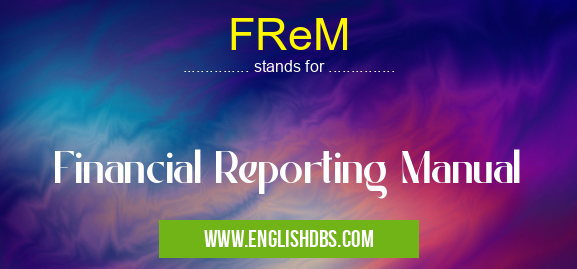What does FREM mean in ACCOUNTING
FReM stands for Financial Reporting Manual, a document issued by an accounting organization that provides guidance and information on the fundamentals of financial reporting. This document serves as a guide to organizations when preparing their own financial statements. It includes details related to the types of accounts, accounting principles, note-taking procedures, and other significant financial reporting topics. The FReM is used as a reference by the auditors and analysts when assessing total liabilities and assets of an organization. It helps identify potential problems with existing methodology and makes recommendations for improving overall accuracy in financial reporting processes. By having detailed instructions readily available, organizations are better equipped to create accurate financial reports in compliance with accepted standards and regulations.

FReM meaning in Accounting in Business
FReM mostly used in an acronym Accounting in Category Business that means Financial Reporting Manual
Shorthand: FReM,
Full Form: Financial Reporting Manual
For more information of "Financial Reporting Manual", see the section below.
» Business » Accounting
Definition
The Financial Reporting Manual (FReM) is a document that provides guidance and specifications about how organizations should prepare their publications for financial statements and other business documents. It outlines standard practices related to accounting principles, note-taking procedures, types of accounts, external auditor’s responsibilities, specific guidelines related to different industries, and so on. The manual also includes templates for various reports such as balance sheets, cash flow statements, income statements or notes to the accounts which allows companies to create publisher friendly reports quickly.
Benefits
Organizations can benefit from using the Financial Reporting Manual in several ways. Firstly it ensures that all accounting data reported follows acceptable regulations and standards which makes it easier for external auditors to review reliable documents without having any discrepancies. Additionally FReM provides guidelines for corporate governance issues such as risk management practices which can be valuable resources for directors who need additional information regarding certain policies or procedures they should follow in order to remain legal and compliant with current regulations even if they do not have complete knowledge about them yet. Lastly it can help reduce the time spent on creating financial documents since everything is already laid out according to standards meaning fewer errors occur during preparation stages due its clear instructions on what type of data must be presented when creating particular documents or reports.
Essential Questions and Answers on Financial Reporting Manual in "BUSINESS»ACCOUNTING"
What is Financial Reporting Manual (FReM)?
The Financial Reporting Manual (FReM) provides a comprehensive framework for the preparation of financial statements and other financial information in accordance with generally accepted accounting principles and practices. It is designed to help those tasked with preparing and issuing financial reports understand the various requirements involved in preparing such statements.
How often does the FReM need to be updated?
Generally speaking, the FReM should be reviewed and updated annually. This ensures that there are no significant changes in accounting standards or regulations that require adjustments to how you report information.
What role do auditors have when working with the FReM?
Auditors use the FReM as a reference for their audit work and also use it as a tool to evaluate a company’s financial reporting process. Auditors typically review all financial statements that management prepared using the FReM for compliance with applicable accounting standards.
Is there any guidance available on best practices when utilizing the FReM?
Yes, guidance can be found through various organizations such as the American Institute of Certified Public Accountants (AICPA). Companies can also look into consulting services from firms knowledgeable about current accounting standards and practices or utilize software solutions specifically designed for independent auditing processes.
Can I find sample documents related to the FReM?
There are many sources online including this website where you will find sample financial statements, notes, letters, spreadsheets, disclosure checklists and more for reference.
Is there any kind of training available on understanding and using the FReM?
Yes, certain organizations such as AICPA offer courses designed to provide participants with an understanding of how to apply common accounting concepts when utilizing the FReM.
How does an organization ensure they remain compliant when implementing their accounts using FRem?
Organizations should regularly monitor changes in applicable regulations while following up-to-date procedures for setting up internal controls over their accounts in order to remain compliant with relevant laws or regulations when implementing their accounts using FRem. For example, having an independent third party review all transactions could ensure compliance by ensuring accuracy of data reported within accounts set up using FRem.
What sources should I rely on prior to making decisions related to my accounts set up based on FRem?
Before making decisions related to your accounts set up based on FRem, it’s important that you consult reliable sources such as reputable accounting textbooks/journals or your accountant/auditor who are experienced in understanding applicable accounting principles & regulations. Additionally, you can seek external advice from industry professionals if needed.
Final Words:
The Financial Reporting Manual is an essential tool for companies that need guidance when preparing their financial statements or other relevant documents. It helps ensure that all records are accurate while following accepted standard regulations at all times through its detailed instructions related mostly to accounting principles and note-taking procedures but also guidelines regarding corporate governance issues or specific requirements depending on industry sector where company operates at. Following this manual can save considerable amounts of money both in terms of avoiding costly errors during audit processes but also time spent on analysis since templates provided within the manual allow quick creation of publisher friendly reports.
